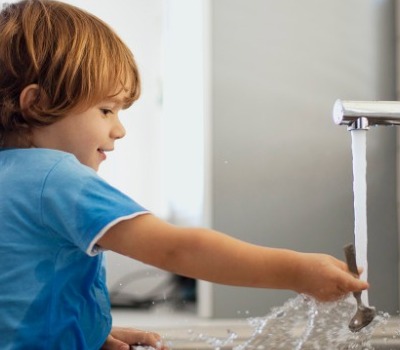A water softener can provide a number of significant advantages for your household, including softer skin and hair, cleaner dishware, and reduced utilities bills – but they do require some maintenance and upkeep in order to ensure continued performance.
Because of this, homeowners have become more drawn to salt-free water softeners in recent years in an attempt to enjoy all the benefits of softer water without having to carry heavy bags of salt or pay to power an additional appliance.
Many homeowners do this under the assumption that salt-free water softeners and salt-based water softeners are essentially the same thing – minus the salt. They are, in fact, very different devices that rely on unique processes to achieve their end goal.
Here is a breakdown of the differences between salt-free water softeners and salt-based water softeners.
Salt-based water softening
Traditional water softeners make use of an ion exchange process that removes magnesium and calcium from your water before sending it throughout the rest of your home. During this process, a negatively charged polymer resin bed in the softener tank attracts and removes hard water minerals and replaces them with sodium ions.
Salt is central to this process, and is also utilized to clean the inside of the softener tank and to regenerate the resin bed. During water softener regeneration, positively charged sodium ions replace the hard water minerals trapped in the resin bed and the hard water concentrate is flushed down the drain.
Salt-free water softening
A common misconception is that salt-free water softening systems remove hard water minerals in the same way a salt-based water softener would. This is not true.
As it turns out, salt-free water softeners don’t actually soften the water at all. They condition it without removing the hard water minerals.
How salt-free water softeners work
The term “salt-free water softener” is typically used to describe the process that should more appropriately be referred to as water conditioning.
Salt-free water conditioning utilizes a water filtration system that crystallizes the hard water minerals magnesium and calcium through a process known as template assisted crystallization (TAC). During TAC, magnesium and calcium are chemically transformed so they no longer cling to surfaces in your plumbing and throughout your house. This dramatically reduces the buildup of scale that can lead to a number of issues, including more expensive utilities bills, appliance wear, and more.
As hard water flows through the conditioner’s tank consisting of polymer beads covered in craters called nucleation sites, the sites act as templates to form hardness micro-crystals. When hard water comes into contact with the beads, the magnesium and calcium ions are caught by the nucleation sites. As the ions build up, micro-crystals are formed, which eventually break off from the beads and release into the water.
The crystals then flow through your plumbing without attaching to your pipes or to your various household surfaces.
As you can see, this salt-free conditioning process doesn’t actually remove the hard minerals from the water. It merely alters them so they don’t cling to your pipes and to other surfaces throughout the home.
Benefits of salt-free water conditioning
Since salt-free conditioning doesn’t entirely remove hard minerals from the water, it doesn’t provide all the same benefits as salt-based water softening. It does, however, have a number of advantages that can make it an appealing addition your home, including:
- Reduced scale buildup
- Low maintenance
- Simple installation
- No need for drainage or regeneration
- No need for electricity
- No cost to operate
Since the hard water minerals are not actually captured or replaced in a tank as with salt-based softening, there is no need for salt or a regeneration cycle to flush the hard minerals when it comes to water conditioning. This combined with the reduced cost compared to electrical softeners can provide some considerable appeal.
Start giving your people better water with Culligan
The first step in determining your water softening or water conditioning needs is to undergo a free in-home water test. This will identify the contents of your water and will help determine the proper next steps for your household.
From there, Culligan Water offers both rental and purchase options for our water softeners and salt-free alternatives. We will work with you to determine the best solution based on your home or office setting, amount of water usage, budget, and more.
Culligan Water also installs and provides expert maintenance for both water softeners and conditioners. Contact us today to start giving your people the water they deserve.





